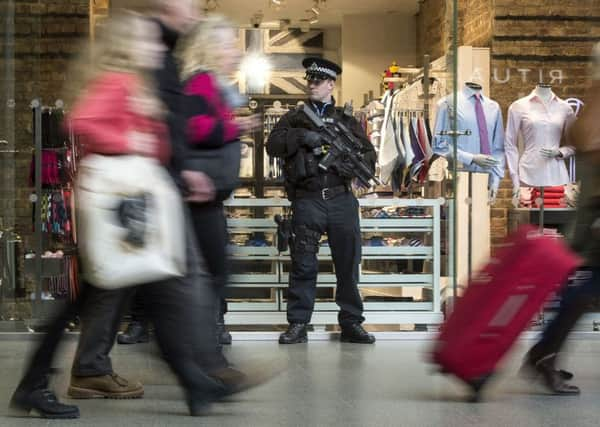Andrew Vine: Good policing still requires a strong and visible presence


It was the morning after the Brussels suicide bombings, and security at the port was tighter than I have ever seen it.
Sniffer dogs checked every vehicle as each drove off the ferry from Zeebrugge, and a policeman looked over the shoulder of the customs official who examined my passport with more than usual care as she asked where I had been and why.
Advertisement
Hide AdAdvertisement
Hide AdBut it was the presence of officers armed with automatic weapons that drew everybody’s attention as they scrutinised each vehicle as it passed, eyeballing every driver and passenger, scanning faces for any signs of guilt or nervousness.
It is a mark of our times that we need such a presence, but their watchfulness made me – and I’m sure every other person disembarking that morning – feel as safe as it is possible to be when terrorism and murderous intent heed no borders, as the people of London, Paris and now Brussels know to their cost.
There really is no substitute for a visible police presence in deterring crime or reassuring the public that the forces of law and order are ever-vigilant.
We want and need to see our police. But it is happening less and less, which is doing both them and us no favours in tackling both commonplace crime and the horrors which the hard-eyed officers with guns were guarding against.
Advertisement
Hide AdAdvertisement
Hide AdThe days of the beat bobby – out on foot patrol, getting to know an area, its people and the threats that may lurk just below the surface – is at risk of becoming a thing of the past.
As a society, our instincts are overwhelmingly to trust the police and put our faith in them for our safety.
Like any service, the police have their occasional flaws. The failure of South Yorkshire Police to tackle widespread child abuse in Rotherham was a stain on that force’s record.
The Metropolitan Police bears a similar mark of shame for its ill-judged hounding of the late Lord Brittan – for so long the highly-respected MP for Richmond, in North Yorkshire – on unfounded allegations of the abuse of children.
Advertisement
Hide AdAdvertisement
Hide AdYet such mistakes do not in the long run fundamentally affect the bond between public and police, which is the healthiest and most mutually respectful of any country.
Regular contact between the police and public has forged that relationship since the dawn of organised policing, but regretfully such interaction appears to be increasingly rare.
Earlier this year, a report by Her Majesty’s Inspectorate of Constabulary found that officers were being taken away from neighbourhood crime prevention duties up to half the time.
And the College of Policing, the professional body that oversees standards, has declared that random patrols “have no crime reduction effect”.
Advertisement
Hide AdAdvertisement
Hide AdTell that to the people coming off the ferry at Hull, who were glad to see such a high-profile presence.
Or to a neighbourhood plagued by drugs, where the mere appearance of a uniformed officer would be enough to scatter the dealers.
Tell it to a woman walking alone at night on a street where gangs of youths are hanging about, and who would feel immeasurably safer if only an officer were nearby.
There can be no question, as police numbers fall, that greater emphasis will have to be placed on intelligence-led policing that targets known offenders.
Advertisement
Hide AdAdvertisement
Hide AdNor can the boom in cyber-crime be tackled by officers pounding the beat.
Bald statistics justify the College of Policing’s view, and it can also point to a generally downward trend in crime over the past 20 years as solid and welcome evidence that the police are getting it right.
But there is more to this than statistics. The police withdraw from being a visible presence on the streets at peril not just to their relationship with the communities they safeguard, but to their effectiveness too.
Now, perhaps more than ever before, there needs to be a closeness between police and public, and that can only be maintained by regular contact beyond moments of crisis and crime.
Advertisement
Hide AdAdvertisement
Hide AdThe twin effects of deterrent and reassurance of those armed officers in Hull is only one side of the equation in combating terrorism, or the vast array of other crimes that the police are called to deal with. The other side is being out there, talking to communities, listening, getting to know residents and developing bonds of trust.
At one level, it is about hearing about the mundane and petty, the garage break-ins and the vandalism. But being visible and listening are the building blocks of relationships in which people have the confidence to pass on information about serious and organised crime, or worse.
It is within communities where whispers of extremism will be picked up.
Those whispers cannot be heard from inside a patrol car. The police need to stay out there on foot patrol, because old-fashioned though it may seem, it is a state-of-the art weapon against the most dangerous threats we face.